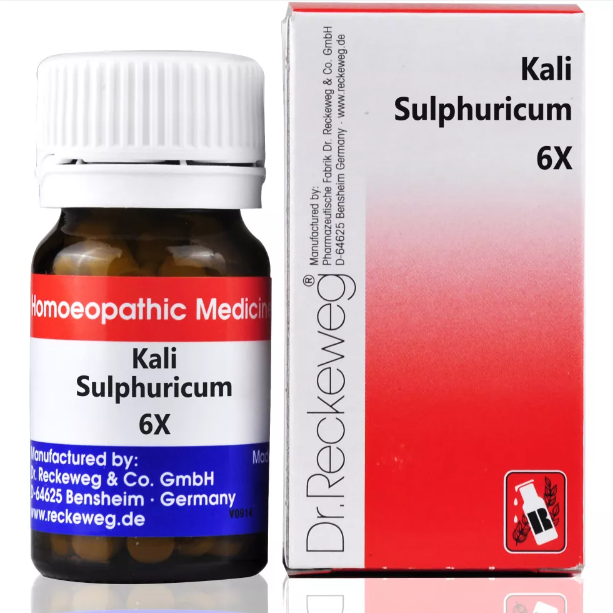KALIUM SULPHURICUM 6x, 12x, 30x, 200x, 6C, 12C, 30C, 200C, 1M, 10M USES AND SYMPTOMS
 KALIUM SULPHURICUM ( Kali Sulph )
KALIUM SULPHURICUM ( Kali Sulph )
(Potassium Sulphate)
Kali-s.
Ailments with profuse desquamation. Suitable for later stages of inflammation. Yellow, mucus and serous discharges, profuse and intermittent. Effective for oxaluria.
Head: Rheumatic headache in the evening. Bald spots, dandruff, and crusty eruptions.
Ears: Eustachian deafness. Yellow discharge (otorrhea) (Hydr.).
Nose: Colds with yellow, slimy expectoration. Obstructed nose, anosmia (Nat-m.). Engorged naso-pharyngeal mucous membrane, mouth breathing, snoring after adenoid removal.
Face: Aches in a heated room. Epithelioma.
Stomach: Yellow, slimy coated tongue. Insipid, pappy taste. Painful gums, burning thirst, nausea, vomiting, sensation of a load, dread of hot drinks.
Abdomen: Colicky pains, cold to touch, tympanitic, tense. Yellow, slimy diarrhea. Constipation with hemorrhoids (Sulph.).
Male: Gonorrhea with slimy, yellowish-green discharge. Orchitis, gleet.
Female: Late, scanty menses with a sensation of weight in the abdomen. Metrorrhagia.
Respiratory: Coarse rales, rattling mucus in the chest (Ant-t.), post-influenza cough in children, bronchial asthma with yellow expectoration. Evening and hot atmosphere worsen cough, croupy hoarseness (Hep., Spong.).
Extremities: Pain in nape, back, limbs, worse in a warm room. Shifting, wandering pains.
Fever: Night temperature rise. Intermittent fever with a yellow, slimy tongue.
Skin: Psoriasis (Ars., Thyr.), eczema with burning, itching, papular eruptions. Nettle rash, polypi, epithelioma, seborrhea, favus, ringworm of scalp or beard with abundant scales.
Modalities: Worse in the evening and in a heated room. Better in cool, open air.
Relationship: Compare: Kalium sulphuricum chromicum-Alum of chrome-3x (produces fine threads in the nasal passages, nasal affections, hay fever, chronic colds, sneezing, red, watery eyes, mucous membrane irritation). Puls., Kali-bi., Nat-m.
Dose: Third to twelfth potency.
SYMPTOMS OF KALIUM SULPHURICUM
Head:
Rheumatic headache, especially in the evening.
Bald spots and dandruff.
Crusty scalp eruptions.
Ears:
Eustachian tube deafness.
Yellow discharge from the ears (otorrhea).
Nose:
Colds with yellow, slimy mucus.
Nasal obstruction and anosmia.
Engorged naso-pharyngeal mucous membrane, mouth breathing, and snoring, even after adenoids are removed.
Face:
Aches in a heated room.
Epithelioma.
Stomach:
Yellow, slimy tongue coating.
Insipid, pappy taste, painful gums.
Burning thirst, nausea, vomiting, and a heavy sensation.
Dislike for hot drinks.
Abdomen:
Colicky pains, cold abdomen, tense and tympanitic.
Yellow, slimy diarrhea and constipation with hemorrhoids.
Male:
Gonorrhea with yellowish-green discharge.
Orchitis and gleet.
Female:
Late, scanty menses with a sensation of heaviness in the abdomen.
Metrorrhagia.
Respiratory:
Coarse rales and chest mucus rattling.
Post-flu cough, especially in children.
Bronchial asthma with yellow expectoration.
Evening and hot weather worsen the cough.
Croupy hoarseness.
Extremities:
Pain in the nape, back, and limbs, worse in a warm room.
Shifting, wandering pains.
Fever:
Nighttime temperature rise.
Intermittent fever with a yellow, slimy tongue.
Skin:
Psoriasis, eczema with burning and itching,
Papular eruptions, nettle rash, polyps,
Epithelioma, seborrhea, favus, and ringworm
Scalp or beard with abundant scales.
Modalities:
Worse in the evening and heated rooms.
Better in cool, open air.
selection of the potency
Individualization:
- Homeopathy is based on the principle of treating the individual, not just the disease. The unique symptoms and characteristics of the person are crucial in determining the most suitable potency.
Intensity of Symptoms:
- The intensity of the symptoms guides the choice of potency. If the symptoms are intense and acute, a lower potency (e.g., 6C, 30C) might be considered. For chronic conditions with less intensity, higher potencies (e.g., 200C, 1M) may be appropriate.
Sensitivity of the Patient:
- Some individuals are more sensitive to homeopathic remedies, while others may require higher potencies. The practitioner considers the patient’s sensitivity when selecting the potency.
Acute vs. Chronic Conditions:
- Lower potencies are often used for acute conditions, while higher potencies may be considered for chronic or long-standing issues.
Previous Response to Potencies:
- The patient’s response to previous homeopathic treatments helps guide the choice of potency. If a particular potency has been effective in the past, it may be repeated or adjusted as needed.
Vital Force and Susceptibility:
- Homeopathy views illness as a disturbance in the vital force. The practitioner assesses the patient’s overall vitality and susceptibility to determine the appropriate potency.
Aggravation or Amelioration:
- The direction of the symptom response (aggravation or amelioration) after taking a remedy can influence the choice of potency.
Miasmatic Considerations:
- In classical homeopathy, the concept of miasms (inherited disease tendencies) is considered. The practitioner take this into account when selecting the potency.
Practitioner Experience:
- The experience and preference of the homeopathic practitioner play a role. Some practitioners may have success with certain potencies based on their clinical experience.
SAFETY INFORMATION
- Do not exceed the recommended dose by physician
- Keep out of the reach of children
- Store in a cool dry place away from direct sunlight
- Maintain half an hour gap between food/drink/any other medicines and homoeopathic medicine
- Avoid any strong smell in the mouth while taking medicine e.g. camphor, garlic, onion, coffee, hing
Medicine images use for reference only selection of homeopathic medicine depends on the individual’s specific symptoms and overall constitution. Moreover, homeopathy is a holistic system of medicine that treats the individual as a whole. In addition to addressing the physical symptoms, it takes into account the emotional and mental state of the person. Consequently, it’s crucial to consult with a qualified homeopathic practitioner for personalized treatment.
The information provided on this website is intended solely for educational purposes. Always seek the advice of your physician or other qualified health provider.
